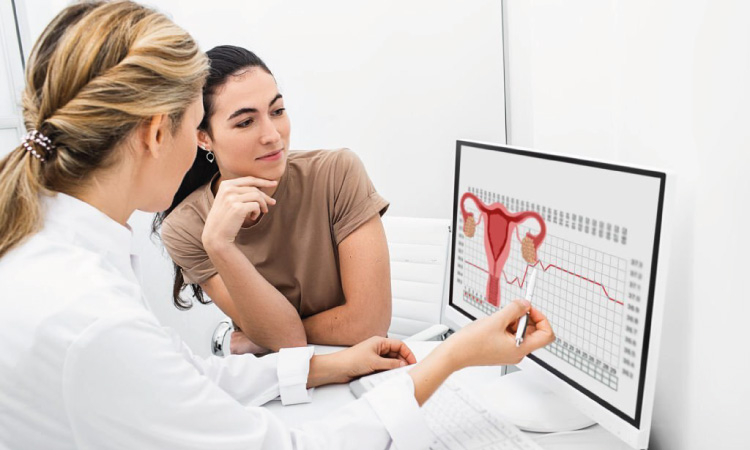To know how likely it is to get pregnant right after a period, you must understand what happens after your period ends. A woman’s period is marked by the complete shedding of her unfertilized eggs and her uterine lining. Immediately following the end of one menstrual cycle, female genital tissues begin to prepare for the next cycle. The uterine lining thickens and becomes spongy again (your next cycle would begin with this being released if you do not become pregnant). The likelihood of pregnancy increases as your body moves towards your most fertile period.
Pregnancy and periods go hand in hand. Monitoring your menstrual cycle is crucial whether you are trying to conceive or trying to avoid getting pregnant. According to popular belief, getting pregnant right after your period is not possible. However, some people are indeed able to conceive immediately after menstruation. What are the chances of pregnancy just after periods? Let’s find out.
Can I Get Pregnant Just After My Periods End?
Chances of pregnancy just after periods are low, but it is not impossible. Several factors determine a woman’s chances of getting pregnant right after her period, such as how short her menstrual cycle is, or how long her period lasts. One must be able to differentiate between getting pregnant and know if periods are coming.

Having a short cycle and a longer period could increase a woman’s likelihood of getting pregnant just after her period. If the menstrual cycle is short, say, 22 days for example, and if the period lasted seven days, then the woman could ovulate just days after her period.
Related Reading: 7 Best Foods To Increase Fertility
How do you get pregnant soon after periods?
Sperms can survive within cervical mucus and the upper genital tract for three to five days1. A woman who ovulates a little bit earlier than usual may therefore have a chance of getting pregnant. If a woman has a shorter cycle, say every 21 to 24 days, that means she is ovulating earlier in the cycle.
Calculate Due Date With Conception Date
If she has unprotected intercourse towards the end of her period, the sperms can survive in her body for up to 5 days, increasing the chance of fertilizing the ovum 4 or 5 days later. Therefore, getting pregnant at any point in the menstrual cycle is technically not impossible, especially for those who have irregular periods.
Thus, pregnancies can occur before, during, or straight after menstruation. However, it is less likely to get pregnant right after a period, as compared to a few days or a week after the period
Factors That Contribute In Getting Pregnant Right After Period

According to studies, women’s fertile windows tend to be erratic, even when their cycle is usually regular. In other words, anyone ovulating normally around day 17 or 18 may sometimes ovulate earlier.
The chances of pregnancy just after periods increase if:
- The couple often engages in unprotected sexual activity
- The woman’s menstrual cycle is very short or irregular
- The woman is over 40, or nearing menopause. (Here also the ovulation will be unpredictable)
Related Reading: How To Prepare Body For Pregnancy After 30
How Many Days After My Period Can I Get Pregnant?
People with very short cycles typically ovulate around day 10. A woman who has a short cycle and has had sex in the days preceding ovulation is theoretically capable of becoming pregnant as early as 2 days after her period2.
What Is A Safe Period Chart?
A woman’s ‘safe period’ is when she has the lowest chance of conception. It is therefore the right time to have sex with your partner if you do not wish to have children or do not intend to use contraception. If you intend to get pregnant, of course, it is not necessary to have sex during these days. However, the safe periods aren’t that clear-cut. You may be able to find the safe period with the help of a chart. You can also use it and look for signs of ovulation to know your most fertile time.
Before you create safe period charts, record the length of your menstrual cycles for at least six cycles. Period tracking apps or a regular calendar will do this for you. Note the day on your calendar when your period starts. You should also note when your next period starts. You should count the number of days between each cycle. Ideally, you should track at least six cycles, but a few more months are even better.
The safe period calculation is accurate if you have a menstrual cycle that lasts between 26 and 32 days. In cases where the cycle is less than 26 days or more than 32 days, the safe period estimation will not work.
Related Reading: 18 Early Signs Of Pregnancy Before Periods
How to chart the safe period?
To predict the first unsafe day (a higher chance of conceiving if unprotected sex occurs) in your current cycle, you must:
- From the tracked 6 (or more) menstrual cycles, find the shortest one.
- You need to deduct 18 from the total number of days in that cycle.
- Count the number you received in the above step from day 1 of your current cycle, and mark that day with an X. (Be sure to count day 1). That day is your first unsafe day. All days before that are considered safe days.

If your shortest cycle is 26 days, you can deduct 18 days from 26. Record your period the moment it begins. Count 8 days from the first day of your period. For example, if day 1 occurs on the 4th of the month (as in the above chart), you will mark X on the 11th. It is therefore your first fertile day for this cycle. The days from 4th to 10th can be regarded as safe days.
The last fertile day in your current cycle can be predicted as follows:
- Determine which of the previous 6 or more cycles you charted had the longest cycle.
- Deduct 11 from the total number of days in that cycle.
- Count the number you received in the above step, from day 1 of your current cycle, and mark that day with an X.
In the above chart, the longest cycle is 30 days long, so take 11 from this. 30-11= 19. Now, start counting 19 days starting from day 1 (which is the fourth of the month in this case). This will bring you to the 22nd. Mark X there. This means the fertile window ends on the 22nd. From the next day to the end of the period, safe days begin. Using the calendar method, we can only predict possible fertile windows and safe days. It is not 100% accurate.
Related Reading: Fertility Tests To Take Before Trying To Get Pregnant
Conclusion

Ovulation cycles differ from woman to woman. This means it is possible to become pregnant during your period. Pregnancy is less likely in the early days of your period but becomes more likely as your period continues.
FAQS
Upon the end of your menstrual cycle, you will be walking towards your fertile window or ovulation period. In addition, sperm can survive in a female body for about 3-5 days.
Based on these facts, you can become pregnant if you have sex 24 hours after your period.
During periods, it is not advisable to engage in unprotected sex. There is a risk of infection. Infections related to period sex are the most common yeast infections.
Utilizing birth control measures, such as a condom, may reduce your chances of contracting this infection and your chances of getting pregnant. However, orgasm during period may help reduce the menstrual cramps.
It is extremely unlikely that you will become pregnant right before your period. It is fairly safe to assume your ovulation occurred between days 11 and 21 if you’re a woman who typically has a 28- to 30-day cycle. Fertilization of the egg ejected by the ovary can only take place between 12 and 24 hours after ejection.
Thus, the days right before your period are the best to engage in sexual activity without worrying about getting pregnant. Longer cycles are associated with more “safe days” and shorter cycles with fewer days before your period.
Right after your period, you can get pregnant since you’re moving into your fertile window. When you stop bleeding on Day 6, have sex on Day 7, and ovulate on Day 11, there is a chance that you will still have sperm from Day 6 in your fallopian tubes that can potentially fertilize the egg. The chances of becoming pregnant are higher after a period rather than before one.
